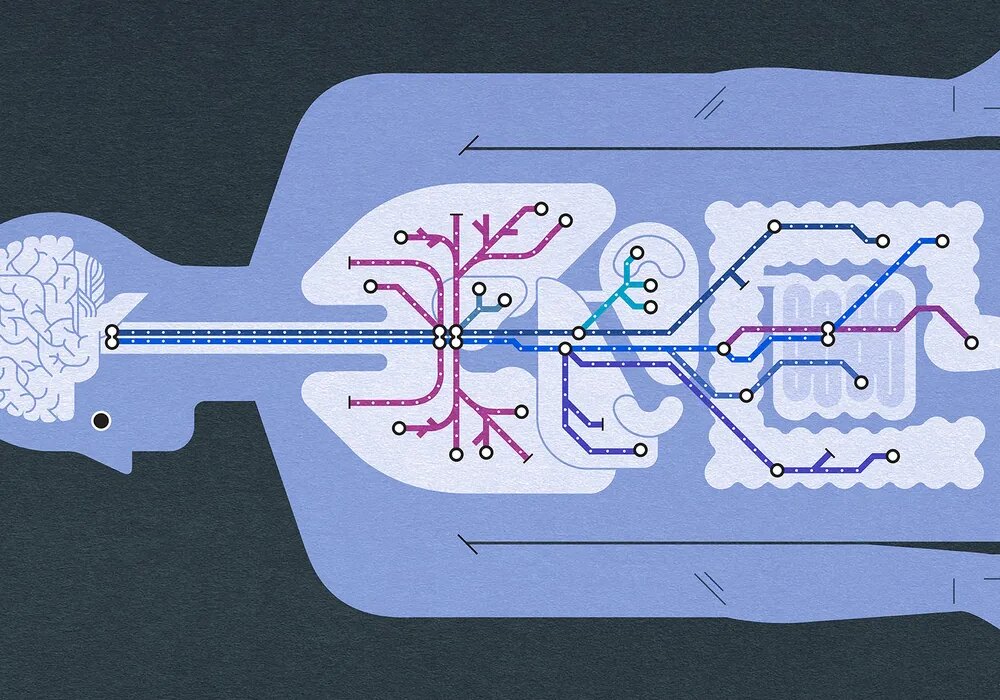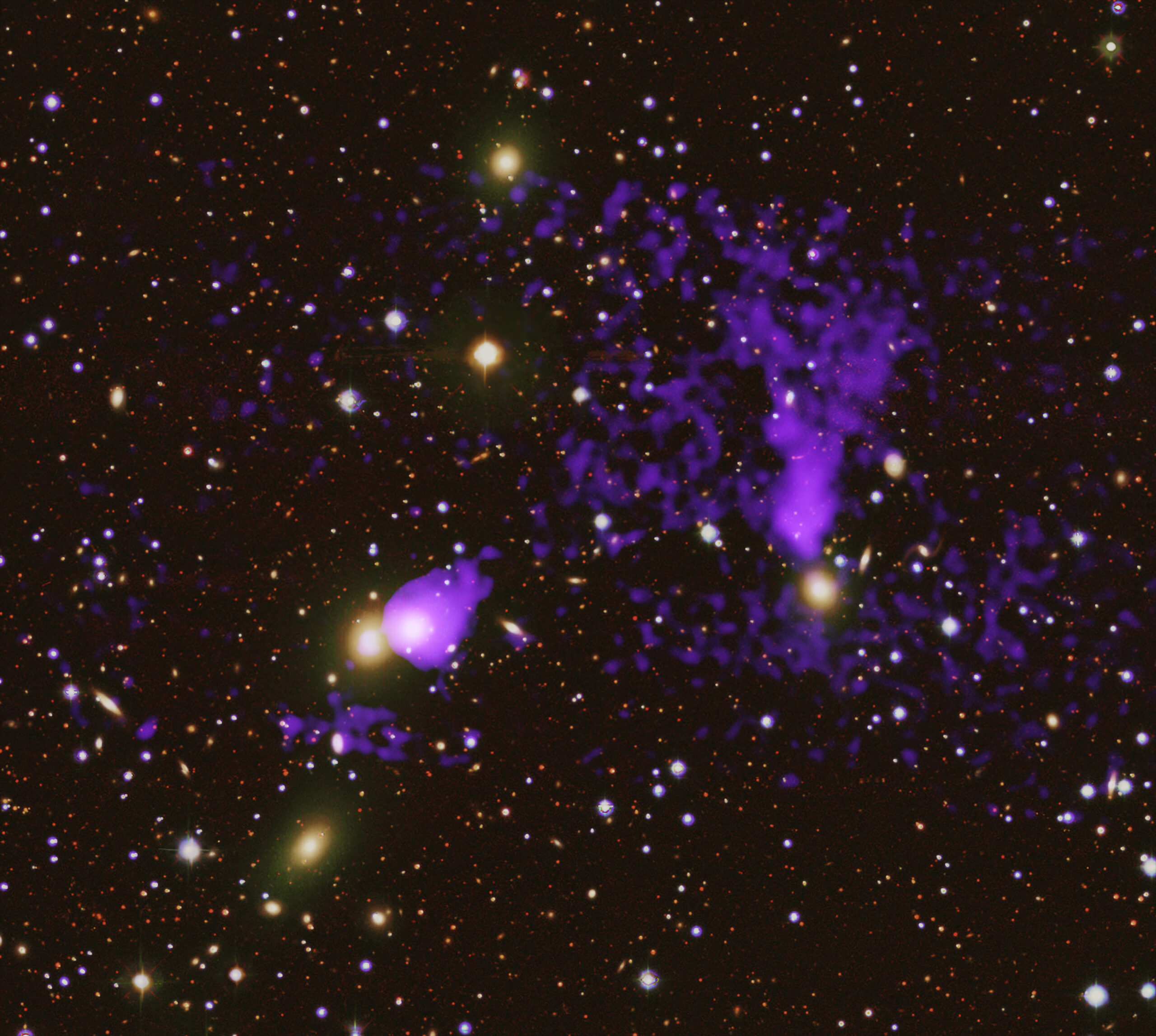The vagus nerve sprawls from the brain through the body, innervating our organs and managing life support and emotion.
Sally Caulwell for Quanta Magazine
The original version of this story appeared in Quanta Magazine.
It is late at night. You are alone and wandering empty streets in search of your parked car when you hear footsteps creeping up from behind. Your heart pounds; your blood pressure skyrockets. Goose bumps appear on your arms, sweat on your palms. Your stomach knots, and your muscles coil, ready to sprint or fight.
Now imagine the same scene, but without any of the body’s innate responses to an external threat. Would you still feel afraid?
Experiences like this reveal the tight integration between brain and body in the creation of mind—the collage of thoughts, perceptions, feelings and personality unique to each of us. The capabilities of the brain alone are astonishing. The supreme organ gives most people a vivid sensory perception of the world. It can preserve memories, enable us to learn and speak, generate emotions and consciousness. But those who might attempt to preserve their mind by uploading its data into a computer miss a critical point: The body is essential to the mind.
How is this crucial brain-body connection orchestrated? The answer involves the very unusual vagus nerve. The longest nerve in the body, it wends its way from the brain throughout the head and trunk, issuing commands to our organs and receiving sensations from them. Much of the bewildering range of functions it regulates, such as mood, learning, sexual arousal and fear, are automatic and operate without conscious control. These complex responses engage a constellation of cerebral circuits that link brain and body. The vagus nerve is, in one way of thinking, the conduit of the mind.
Nerves are typically named for the specific functions they perform. Optic nerves carry signals from the eyes to the brain for vision. Auditory nerves conduct acoustic information for hearing. The best that early anatomists could do with this nerve, however, was to call it the “vagus,” from the Latin for “wandering.” The wandering nerve was apparent to the first anatomists, notably Galen, the Greek polymath who lived until around the year 216. But centuries of study were required to grasp its complex anatomy and function. This effort is ongoing: Research on the vagus nerve is at the forefront of neuroscience today.
The most vigorous current research involves stimulating this nerve with electricity to enhance cognition and memoryand for a smorgasbord of therapies for neurological and psychological disorders, including migraine, tinnitus, obesity, pain, drug addiction and more. But how could stimulating a single nerve potentially have such wide-ranging psychological and cognitive benefits? To understand this, we must understand the vagus nerve itself.
The vagus nerve originates from four clusters of neurons in the brain’s medulla, where the brainstem attaches to the spinal cord. Most nerves in our body branch directly from the spinal cord: They are threaded between the vertebrae in our backbone in a series of lateral bands to carry information into and out of the brain. But not the vagus. The vagus nerve is one of 13 nerves that leave the brain directly through special holes in the skull. From there it sprouts thickets of branches that reach almost everywhere in the head and trunk. The vagus also radiates from two major clusters of outpost neurons, called ganglia, stationed in critical spots in the body. For example, a large cluster of vagal neurons clings like a vine to the carotid artery in your neck. Its nerve fibers follow this network of blood vessels throughout your body to reach vital organs, from the heart and lungs to the gut.
The vagus nerve connects the brainstem to the body’s organs. Mark Belan for Quanta Magazine/https://tf-cmsv2-smithsonianmag-media.s3.amazonaws.com/filer_public/6d/bd/6dbd745d-17dc-4f8b-ac67-6e573581f29a/1_vagus_nerve-crmarkbelan-desktop-v1_web.jpg)
As with the brain itself, with its mirrored left and right hemispheres, we have left and right vagus nerve branches, which connect to the two hemispheres. But the organs in our body are not bilaterally symmetrical: The heart is on the left side, and the liver is on the right, for example. The right vagal nerve, then, is longer than the left, and the two sides have distinct functions because of the different organs they entwine.
It feels particularly apt to compare the vagus nerve to a highway network, with paths diverging, branching off again and again, and sometimes coming back together. Just as roads are given different names, many vagus nerve branches are given distinct names for the destinations they reach. They might run in tandem with the main sections of the vagus for brief intervals before separating again.
All complex body systems require the equivalent of brakes and a gas pedal to maintain control, and the vagus nerve serves these roles for many of our innate responses, nearly all of which occur involuntarily. Signals between the brainstem and the body travel up and down the nerve to twist your gut for digestion, marshal your immune system to keep microbial threats at bay, pace your heart, and dial your blood pressure up and down. The vagus nerve squeezes your bronchial tubes to pipe air into your lungs, triggers your gag reflex and makes you cough.
Its influence goes beyond basic life support: The vagus nerve is critical to generating mind by integrating the brain and body. Choking is terrifying because death could be mere minutes away. That heightened mental state is dependent on signals coming from the body—the inability to breathe or swallow—and the vagus nerve both senses and controls the choking response. If your heart suddenly starts racing, you might experience a panic attack; controlling heart rate is a prime function of the vagus nerve. Many other mental states, sexual arousal for example, depend on the mind-body connection that involves information going to the brain (sensual touching, for example) and out of the brain (to arouse bodily responses). The vagus nerve is that connection. Its length and widespread nature throughout the brain as well as the body allow it to coordinate such diverse bodily functions in a way that independent nerves could not.
The primary function of the vagus nerve is to dampen the body’s responses. After a fear episode, for example, the body’s powerful, life-saving threat response must be terminated to restore resting heartbeat, respiration, blood flow and the rest. So powerful is its influence, the vagus nerve can literally stop the beating heart. Conversely, the vagus nerve can also stimulate bodily responses by releasing the brakes to accelerate.
The calming action of the vagus nerve is the biological basis for new therapies that aim to stimulate the nerve to quell seizures, relieve anxiety disorders, cool the body’s inflammatory response and stanch a migraine attack, among a long list of potential treatments. Unlike deep-brain stimulation, which is used to treat some of the same conditions, vagal nerve stimulation can be accomplished without neurosurgery. It is possible to stimulate the nerve fibers with a mild electrical pulse by surgically inserting electrodes into the chest or, more simply, clipping them to an earlobe. The technique has been used to treat epilepsy and depression for decades, and in 2021 the U.S. Food and Drug Administration approved it to treat mobility issues caused by stroke.
However, some people have taken the vagus nerve’s expansive bodily influence as an invitation to engage in pseudoscience. In some corners of the internet, so-called polyvagal therapy—physical or breathing exercises that some claim reset the vagus nerve—is proposed to address just about any disorder of the mind or body. There’s little to no evidence that these popular remedies are anything but placebos.
The vagus nerve doesn’t need to be a panacea to be remarkable—it’s worth appreciating all on its own. Without the expansive domain and potent impact of the body’s longest nerve, the crucial, highly coordinated link between brain and body would be broken, and many of our core emotions and experiences—fear, pleasure, rapid response to threats, the calming aftermath—would fail.
This article was originally published by QuantaMagazine.org, an editorially independent online publication launched by the Simons Foundation to enhance public understanding of science.




